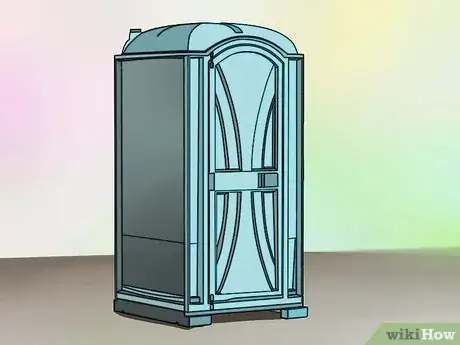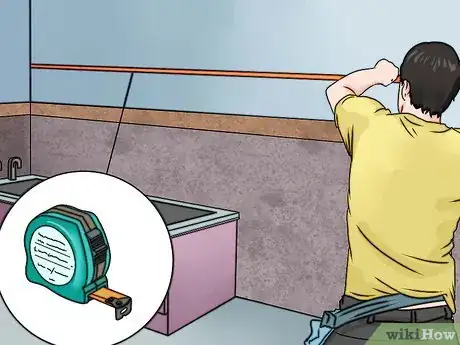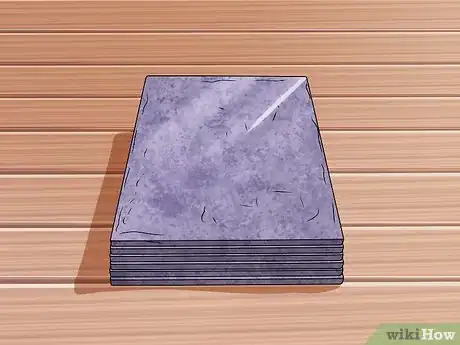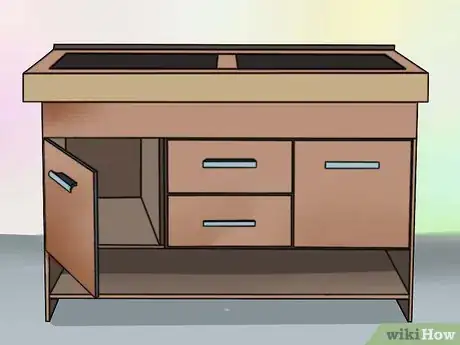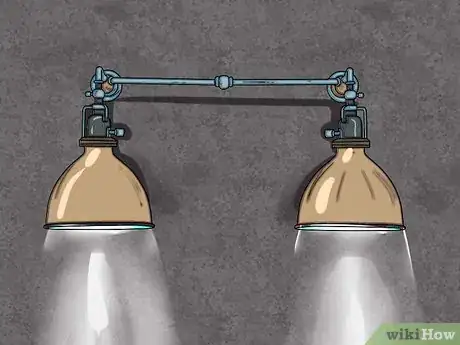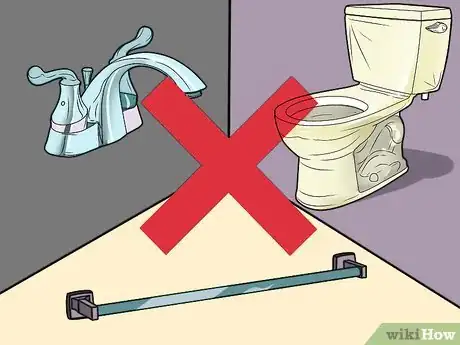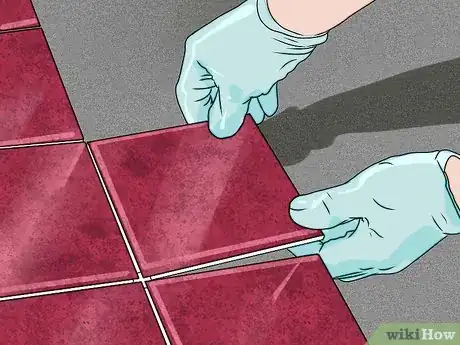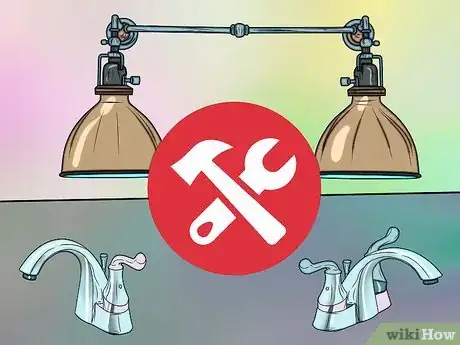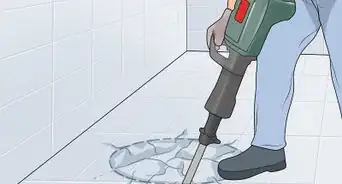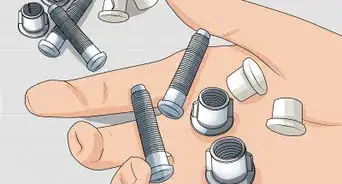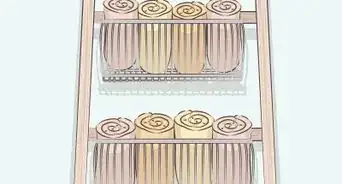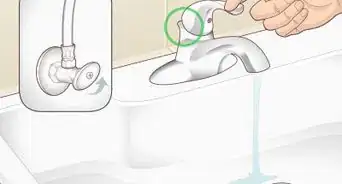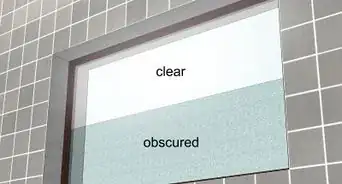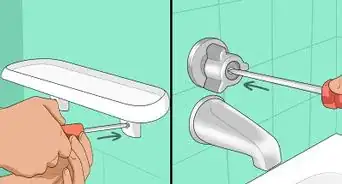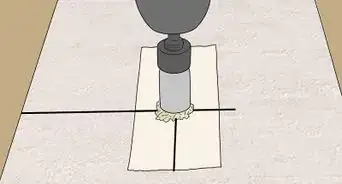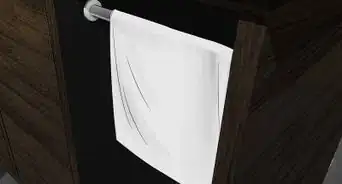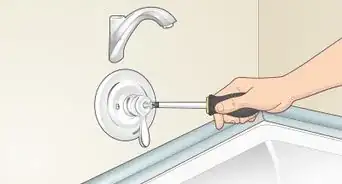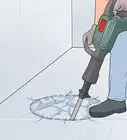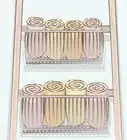This article was co-authored by Art Fricke. Art Fricke is a home renovation and repair specialist and the owner of Art Tile & Renovation based in Austin, Texas. With over 10 years of experience, he specializes in bathroom and kitchen renovations. Art focuses on a single contractor approach to customized renovation work, and performs projects such as installing custom tile showers, fixing tiled shower leaks, replacing cracked tiles, and installing floor and wall tile.
This article has been viewed 66,708 times.
Renovating a bathroom can be as simple as changing out towel rods and faucets for new ones, or as complex as knocking down walls and rearranging tubs and toilets. It can be quite intimidating, especially if you don't know where to begin. This article will give you the basics of how to renovate a bathroom.
Steps
Planning the Design and Budget
-
1Decide how you want the bathroom to look like. Think about what mood, theme, and color scheme you want.[1] This is also a good time to think about new faucets, towel rods, door knobs, tiles, and so forth. Great places to get ideas include websites such as Pinterest and home design magazines. Be sure to save pictures of bathrooms you like. Here are some other design ideas to get you started:
- Go with a theme, such as country or ocean. Write down things that might go with that theme, such as rustic wood, lavender, lighthouses, or starfish.
- Go with a color scheme, such as all blues or all greens.
- Go with a limited, modern look or an ornate, old-fashioned look.
-
2Plan a budget. The more you plan on doing to your bathroom, the more money you will have to spend. Something as simple as changing out a light bulb or faucet probably won't be very expensive. Things such as adding a shower, or removing a wall, however, may require a higher budget.
- Just because something is out of your budget does not mean that you should abandon your design. You could always go for a cheaper item that looks similar or buy the item when it goes on sale.[2] Many hardware stores also offer promotions and coupons.
- Prioritize your money when you budget. If you want a new vanity but flooring is more important, make that your priority when shopping.
Advertisement -
3Think about how much work needs to be done, and what sort of work. There are different types of renovations, and each requires a different amount of work, time, and money.[3] Some renovations may also require the aid of a trained professional, for which you will need to hire a contractor.
- Simple renovations include things like painting the walls, adding faucets, or changing the towel rack and lights. This sort of work can be done by anyone, and won't take very long.
- Complex renovations include things like removing or adding walls, replacing bathtubs, adding a shower, or moving a toilet to another spot. These sorts of renovations require a contractor to do the work for you and may require some time to complete.
- If there’s something you can do by yourself, start whenever you have extra time. Otherwise, you need to schedule for contractors and others to help you.
-
4Decide how much time and effort you want to spend on your bathroom. Things like switching out old light bulbs for new ones won't take that much time or effort. Changing a bathtub or moving a toilet also won't take much work from you, because they will be completed by a trained professional instead. Painting and adding new tiles, however, may take a lot of time and effort, especially if you choose to do the work yourself. For example, paint needs time to dry, and tiles need to be laid out in grout. This may also affect your budget.
- You can do most of the work yourself, but it will take a lot of time and effort. It will, however, be much cheaper than hiring someone to do it for you.
- You can also hire a professional instead. This may cost you more money, but you won't have to lift a finger or get dirty. Most professionals get their work completed quickly because they have done it many times before.
- Just because a bathroom is small does not mean that it will be finished sooner. If you need to order supplies, such as tiles, a small bathroom can take just as much time as a large bathroom.[4]
- If you want your bathroom finished quickly, try giving it a cosmetic facelift instead of a full renovation.
-
5Consider asking a professional designer for help. If you don't know where to begin when it comes to design work, you could hire an architect or interior designer to design a bathroom for you. He or she will know how to work with different colors and materials to create something visually pleasing. The architect or designer will also know how to place things in your bathroom to make them more efficient.
-
6Know when you need to hire a contractor or trained professionals. If you need to do anything to the plumbing or electrical wires, you will need to hire a contractor.[5] He or she will then take care of hiring workers, salaries, working hours, and so forth. If you ever don’t feel comfortable doing a task, reach out for someone to help out.
-
7Make sure that your new bathroom meets building codes while still being comfortable. Some places require certain rooms, such as bathrooms, to be a specific size. If the final design does not meet the requirements, the city won't approve your re-design, and you won't be able to renovate your bathroom. Be sure to check with your city if you plan on re-sizing your bathroom, and make sure that your design is meeting the building code. Here are some other things to keep in mind:[6]
- Half baths usually range between 3 to 4 feet wide and 6 to 8 feet long in the United States. The larger the half bath is, the more comfortable it will be.
-
8Take advantage of the space in a master bathroom. Master bathrooms are meant to be used by two people. If planned correctly, they can be quite comfortable and roomy. If planned incorrectly, however, they can become cramped and lead to unnecessary elbow-jostling. Here are some ideas to get you started:[7]
- Consider adding in a separate toilet room with a door; this will give you and your partner more privacy.
- Having both a shower stall and a bathtub will allow two people to get clean at the same time.
- If you choose to have two sinks, make sure that they are at least 36 inches (91.44 centimeters) apart. This will give both people enough space to spread out and not worry about bumping elbows.
- Be sure to include pathways. If two people are going to be using the bathroom at the same time, they will need enough space to pass by each other. Plan on having 36 to 42 inches (91.44 to 116.84 centimeters) wide pathways in the bathroom.
- Consider adding cabinetry along one wall to use for a linen closet to store bathroom supplies and towels.
-
9Have a backup bathroom. This is especially important if you are making renovations that involve plumbing. The last thing you'd want is to be stuck without a toilet or shower for several days. If you don't have a spare bathroom, you may need to install a portable toilet and an outdoor shower.
Choosing the Materials and Fixtures
-
1Take measurements of everything before you go shopping.[8] You will need to know the exact size of your bathroom, including the width, length, and height. You will also need to know the dimensions of other things, such as toilets, bathtubs, sinks, showers, and cabinets.[9]
- If you don't take proper measurements, you may buy something in the wrong size. Taking measurements early will prevent the hassle of trying to return something that doesn't fit.
- Take photos of your space so you can easily remember a color or visualize what a fixture would look like in your space.
-
2Choose slip-free, non-absorbent flooring. There are different types of floor material that you can use in a bathroom. In general, what you pay is what you get. If you want something that looks good, is high quality, and lasts for a long time, you will need a larger budget. Here are some things to keep in mind:[10]
- Porcelain and glazed tiles are easy to clean and take care of.
- Marble and granite are expensive, but they look great.
- Avoid porous stone, such as limestone. They absorb stains easily, which makes them difficult to clean. If you want natural stone, then make sure that it is sealed.
- Try to get something that is non-slip. Look for textured or matte finishes, or glazes that have sand in them.
- Keep painted or stained cement in mind.
- You can also get sheet vinyl or vinyl tiles. They are less expensive than the real thing, but they may not look or feel as great either.
- If you have vinyl or linoleum, you can apply a peel-and-stick tile on top of the existing floor.
-
3Choose moisture and mildew-resistant paint. Because bathrooms get damp, wallpaper is not a good idea.[11] The best paint to use for a bathroom is something that is either semi-glossy or satin; both are resistant to frequent cleaning and touching. Textured paint is also a great option if you are re-painting an old surface; the texture will conceal any bumps and imperfections. Whatever paint you decide to use, make sure that it is intended for bathrooms, and is both moisture and mildew proof.
- Use light colors, such as sky blue, seafoam green, or lavender, if you have a small bathroom. They will make your bathroom appear bigger than it actually is.
- Use darker colors to make large bathrooms appear smaller and cozier.
- Go for gray or white if you can't decide. They are common bathroom colors.
- Consider adding accent or trim colors to match your decor and towels.
-
4Decide what sort of material you want for your counter. There are different types of materials you can use for your counter if you choose to have one. Here are some things to get you started:[12]
- Natural stone looks and feels luxurious. It is very beautiful, but it needs to be sealed properly so that it does not soak up stains. The drawback is that it can only come in flat slabs.
- Resin is great for counters with irregular shapes. They are a great choice if you want to have a sink molded right into the counter. They can be made to resemble almost any material and don't need to be sealed. Despite this, they don't have the beauty of natural stone.
- Laminate counters are cheap and come in many different finishes. They are also stain and scratch resistant. Unfortunately, they can also fade and deteriorate over time.
- Consider covering your counter with porcelain or glazed tile. This will make it durable, and easier to clean.
- If you have marble or granite throughout your home, consider using it in your bathroom so your home feels cohesive.
-
5Choose your bathtub, sinks, showers, and other fixtures. There are different types of tubs, sinks, and showers. For example, some types of sinks and tubs are free-standing and can be moved around if needed. Other types are directly molded into the counter or wall. Here are some things to keep in mind:[13]
- Pedestal sinks look elegant and take up little space, but they won't fit in a counter, and you can't place a cabinet under them. You will need to install cabinets and counters in other parts of your bathroom. This could also decrease the value of the bathroom if you ever plan on selling your home.
- Vessels and bowls are popular sink choices. They sit right on top of a counter. The downside is that you will need to clean under them, and you can't just wipe things off the counter and into the sink like you would with a molded sink. They also tend to be more expensive than molded sinks.
- Molded sinks are often set right into the vanity. They are the most common, but also the most convenient.
- Claw-foot bathtubs are free-standing and classical. They are often made from porcelain and can hold heat better. You will need to add a drain in the floor to catch any spilled water.
- Molded bathtubs sit right on the floor, and are the most common. They come in all sorts of shapes and sizes. Some even include fancy features, such as benches for shaving on and jet streams.
- Measure the size of your doorframes to make sure the fixtures you want can fit inside easily.
- When you go to buy a bathtub, you might also want to sit in it to make sure that it is comfortable. After all, you will likely sit in your bathtub while using it at home.[14]
-
6Choose storage that is both efficient and stylish. This includes things like storage units, caddies, cabinets, and shelving. You want your storage to look good and be functional. You should be able to reach your cabinets and shelves easily, and have access to them when you need to. You also want your storage to fit everything it needs to fit.
- Use open shelving as an inexpensive alternative to closed cabinets.
- Cabinets don't always have to stick straight out of the wall. Consider having some cabinets recessed into the wall. This will save some space.[15]
-
7Make sure you have adequate lighting in your bathroom. Lighting is very important. If there is not enough lighting, then your bathroom could become dangerous. Take advantage of natural light first by letting as much of it in as possible. Plan on having at least 4 watts of artificial light per square foot.
- You can let lots of natural light into your bathroom with skylights.
-
8Make sure that you have adequate ventilation. Poor ventilation will lead to mold, decay, rot, and smells. Having vents, windows, and fans is always a good idea. When choosing a fan, consider getting a quiet one for master bathrooms, so that you don't wake your significant other if you have to use the restroom at night. Get a noisier one for powder rooms; the noise will give the guest more privacy, especially if the bathroom is close to a living room.[16]
-
9Pick out some new accessories to match your new bathroom. This will include things such as towels, washcloths, and bath mats. It will also include things like soap dispensers, mirrors, and towel racks. Try buying these items when they go on sale. They can be inexpensive, but the price will add up.
Renovating Your Bathroom
-
1Switch off all water valves if you are going to do anything to the sink, bathtub, shower, or toilet. You can find them behind toilets and under sinks. If you don't do this, you might end up with a flood.
-
2Cover anything that isn't getting renovated with plastic or paper to protect it. If you are painting your bathroom, you will want to cover the floors, sinks, counters, toilets, and light switches so that they don't get dirty. You can use paper, cardboard, or plastic sheeting. Be sure to tape the edges down so that the paint or dust doesn't get underneath is.
- If you are removing any knobs, faucets, light switches, or towel rods, be sure to put them into a box so that they stay together. This is especially important if you plan on using these items again.
- Shut the door when you’re finished working for the day so pets or children don’t get inside while the bathroom is still under renovation.
-
3Get rid of anything that you will be replacing. This includes faucets, towel rods, and toilets. The less clutter you have in your bathroom, the easier your renovation will be. You can either donate the items you won't be using anymore, sell them online, or dispose of them according to your city's requirements. Some places will ask you to leave the item outside your home so that it can be picked up and disposed of, while others will require you to take it to a facility.
-
4Start by painting your bathroom. Use a paint roller, and be sure to let each layer dry completely before adding another. Most paints will dry between two to four hours, but you might want to refer to the label on your can of paint for more specific drying times. If you don't do this, the paint may not cure properly and become sticky or bumpy.
- Leave the last coat of paint until after you have installed all cabinets, shelves, sinks, and tubs.
-
5Add tile or new flooring once the paint has dried. This also includes the backsplash tile behind the sink. If you are not changing the floors, then you can remove any protective coverings off the floor at this time.
-
6Install any toilets, sinks, tubs, and showers. You will most likely need to hire a plumber to do this step for you, especially if you are going to move a toilet, sink, tub, or shower from one side of the bathroom to the other. After you have installed the toilet, sink, tub, or shower, be sure to caulk around the edges so that moisture doesn't seep through. If you don't caulk, water will get into the floor and cause mildew.
-
7Install any new cabinets, shelves, cabinets, and towel rods. You can place these wherever you want in your bathroom, but keep in mind that you will need to reach these items easily. Here are some guidelines for to get you started:[17]
- Towel rods should be placed about 4 feet (1.22 meters) above the floor.
- The top of a cabinet should be about 6 feet (1.83 meters) above the floor.
- Place the toilet paper roll holder 6 inches (15.24 centimeters) in front of the toilet.
-
8Install new lights and faucets. Be sure to properly caulk around the faucets after you install them. When buying caulk, try to get an acrylic or hybrid formula. They don't need chemicals to remove. This will make any future re-caulking easier.
-
9Clean any dust, paint, or debris. When you are done renovating your bathroom, peel off any leftover painter's tape and discard any sheets of plastic or paper. Be sure to wipe down the counters and sinks, and to vacuum or mop the floors. This will make your bathroom look better and give it that nice, finishing touch.
Expert Q&A
-
QuestionHow can you make a feasible plan for a bathroom?
 Art FrickeArt Fricke is a home renovation and repair specialist and the owner of Art Tile & Renovation based in Austin, Texas. With over 10 years of experience, he specializes in bathroom and kitchen renovations. Art focuses on a single contractor approach to customized renovation work, and performs projects such as installing custom tile showers, fixing tiled shower leaks, replacing cracked tiles, and installing floor and wall tile.
Art FrickeArt Fricke is a home renovation and repair specialist and the owner of Art Tile & Renovation based in Austin, Texas. With over 10 years of experience, he specializes in bathroom and kitchen renovations. Art focuses on a single contractor approach to customized renovation work, and performs projects such as installing custom tile showers, fixing tiled shower leaks, replacing cracked tiles, and installing floor and wall tile.
Home Renovation & Repair Specialist First, think about what you want to have in the bathroom. Then you can take grid paper and make a footprint of the bathroom to figure out whether your plan can work.
First, think about what you want to have in the bathroom. Then you can take grid paper and make a footprint of the bathroom to figure out whether your plan can work. -
QuestionHow can I get the best results with minimum expenditure?
 Art FrickeArt Fricke is a home renovation and repair specialist and the owner of Art Tile & Renovation based in Austin, Texas. With over 10 years of experience, he specializes in bathroom and kitchen renovations. Art focuses on a single contractor approach to customized renovation work, and performs projects such as installing custom tile showers, fixing tiled shower leaks, replacing cracked tiles, and installing floor and wall tile.
Art FrickeArt Fricke is a home renovation and repair specialist and the owner of Art Tile & Renovation based in Austin, Texas. With over 10 years of experience, he specializes in bathroom and kitchen renovations. Art focuses on a single contractor approach to customized renovation work, and performs projects such as installing custom tile showers, fixing tiled shower leaks, replacing cracked tiles, and installing floor and wall tile.
Home Renovation & Repair Specialist You can choose less expensive materials and still get the best results. For example, instead of using a cast iron soaker tub, you can use an acrylic tub which will be half the cost or less and a lot easier to install.
You can choose less expensive materials and still get the best results. For example, instead of using a cast iron soaker tub, you can use an acrylic tub which will be half the cost or less and a lot easier to install.
Warnings
- If you feel stuck at any point, don't hesitate to hire a contractor or a trained professional. Sometimes, it will cost more to fix a mistake than hiring a trained professional in the first place.⧼thumbs_response⧽
- Be prepared for any hidden issues, such as mold or rust, that may pop up as you renovate your bathroom. Some of these issues may not be noticeable until after you break down a wall, remove a cabinet, or pull up flooring. When these issues do show up, you will need to take care of them. Do not leave things like mold or rust untreated. If you do, it will only get worse.[20]⧼thumbs_response⧽
References
- ↑ Art Fricke. Home Renovation & Repair Specialist. Expert Interview. 1 July 2020.
- ↑ Art Fricke. Home Renovation & Repair Specialist. Expert Interview. 1 July 2020.
- ↑ Art Fricke. Home Renovation & Repair Specialist. Expert Interview. 1 July 2020.
- ↑ Freshome, The 15 Point Checklist Before Starting a Bathroom Renovation
- ↑ Art Fricke. Home Renovation & Repair Specialist. Expert Interview. 1 July 2020.
- ↑ This Old House, Read This Before You Redo a Bath
- ↑ This Old House, Read This Before You Redo a Bath
- ↑ This Old House, Read This Before You Redo a Bath
- ↑ Freshome, The 15 Point Checklist Before Starting a Bathroom Renovation
- ↑ This Old House, Read This Before You Redo a Bath
- ↑ This Old House, Read This Before You Redo a Bath
- ↑ This Old House, Read This Before You Redo a Bath
- ↑ This Old House, Read This Before You Redo a Bath
- ↑ Style at Home, Top 10 Bathroom Renovation Tips
- ↑ Style at Home, Top 10 Bathroom Renovation Tips
- ↑ This Old House, Read This Before You Redo a Bath
- ↑ This Old House, Read This Before You Redo a Bath
- ↑ This Old House, Read This Before You Redo a Bath
- ↑ Freshome, The 15 Point Checklist Before Starting a Bathroom Renovation
- ↑ Freshome, The 15 Point Checklist Before Starting a Bathroom Renovation
About This Article
To renovate your bathroom, begin by painting the walls with semi-glossy or satin paint to prevent mildew or moisture damage. After the walls are painted, lay the tile or another non-absorbent, slip-free flooring. Then, install the fixtures, like bathtubs and sinks, making sure to measure the space in your bathroom before doing so. Next, install cabinets or shelves to store items like towels and toiletries. Finally, hook up the light fixtures, opting for fixtures with at least 4 watts per square foot of bathroom space. For advice on how to pick a countertop material for your sink or bathroom vanity, read on!









